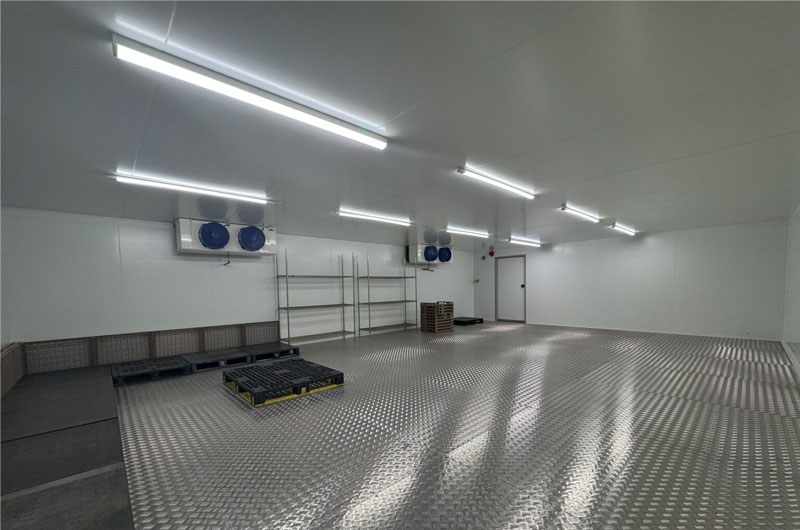Investing in a cold room is a significant decision for businesses in many industries. However, the key to making a smart investment lies in understanding its financial return. A Return on Investment (ROI) calculation helps assess whether a cold room investment will be profitable over time.
1. Understanding ROI in Cold Room Investment
Return on Investment (ROI) is a metric that compares the gain or loss generated from an investment relative to its cost. In simple terms, it answers the question: “How much profit will I make from this investment?”
ROI Formula:
ROI (%) = (Total Net Benefit – Total Investment Cost)/Total Investment Cost × 100%
For cold room projects, ROI involves both tangible and intangible benefits, such as energy savings, reduced spoilage, operational efficiency, and improved customer satisfaction.
2. What Should Be Included in the ROI Calculation?
A. Initial Investment Costs
1. Construction or Installation Costs
- Building materials, insulation, doors, panels
- Refrigeration systems (compressors, evaporators, condensers)
- Floor preparation and leveling
- Lighting and electrical setup
2. Equipment Costs
- Temperature monitoring systems
- Racking and shelving systems
- Backup power systems (generators, batteries)
3. Design & Engineering Fees
- Layout planning, thermal load calculations, airflow design
4. Permit & Compliance Costs
- HACCP, FDA, ISO certifications
- Local building permits and inspections
B. Operating Costs
- Energy Consumption: Cold rooms can be energy-intensive. Monthly utility costs should be factored in, especially when evaluating energy-efficient models versus conventional units.
- Maintenance & Repairs: Includes routine servicing of compressors, fans, door seals, and insulation checks.
- Labor Costs: Staff required for operations, monitoring, and inventory handling.
- Insurance & Security: Cost of insuring the facility and installing surveillance or alarm systems.
C. Financial Benefits (Returns)
- Reduced Spoilage: A major ROI driver, especially for food and pharmaceuticals. For example, reducing spoilage by 15–30% directly translates into retained revenue.
- Energy Savings: Newer models and advanced insulation technologies can reduce power usage by 20–40% compared to older systems.
- Operational Efficiency: Faster inventory handling, better organization with racking systems, and automated monitoring help cut labor costs.
- Increased Revenue Capacity: Being able to store more products or diversify offerings (e.g., frozen & chilled sections) increases overall sales potential.
3. Step-by-Step Guide to Using a Cold Room ROI Calculation
Step 1: Enter Initial Investment
Input total cost of building or upgrading the cold room, including all infrastructure, equipment, and installation charges.
Example:
- Construction: $40,000
- Refrigeration Units: $25,000
- Racking & Shelving: $10,000
- Monitoring & Backup Systems: $5,000
- Total Initial Investment = $80,000
Step 2: Estimate Annual Operating Costs
Include energy, maintenance, staffing, insurance, and compliance costs.
Example:
- Energy: $1,500/month → $18,000/year
- Maintenance: $3,000/year
- Labor: $12,000/year
- Miscellaneous: $2,000/year
- Total Annual Operating Cost = $35,000
Step 3: Estimate Financial Benefits
Quantify gains such as:
- Reduced product spoilage
- Energy savings
- Increased sales
- Improved logistics
Example:
- Spoilage Reduction: $20,000/year
- Energy Efficiency: $5,000/year
- Improved Sales (due to added storage): $15,000/year
- Total Annual Benefit = $40,000
Step 4: Calculate Net Annual Return
Subtract operating costs from financial benefits:
$40,000 (benefits) – $35,000 (costs) = $5,000 net annual return
Step 5: Apply the ROI Formula
ROI = (5,000/80,000)×100% = 6.25%
This means your investment will generate a 6.25% return per year, and you’ll reach a break-even point in approximately 16 years, not accounting for depreciation or inflation.
4. Tools and Templates for ROI Calculation
Several online tools and spreadsheet templates can assist with ROI analysis. Look for calculation that allow you to:
- Input variable energy costs by region
- Set depreciation schedules
- Adjust for inflation or interest rates
- Calculate payback period and Net Present Value (NPV)
Some trusted tools include:
- Cold Chain Calculator by Global Cold Chain Alliance (GCCA)
- Energy ROI Estimator by Department of Energy (DOE)
- Custom Excel ROI Templates (with editable cost-benefit rows)
5. Tips for Maximizing ROI on Cold Room Investment
A. Prioritize Energy Efficiency
Invest in high-efficiency compressors, LED lighting, and motion-activated doors. Consider solar backup systems to reduce energy costs long-term.
B. Plan the Layout Smartly
Avoid wasted space. Integrate optimized racking systems and air circulation pathways to improve cooling efficiency and product organization.
C. Automate Monitoring and Alerts
IoT-based systems can detect faults, send temperature alerts, and help prevent product loss in real time.
D. Schedule Preventive Maintenance
Regular maintenance helps reduce unplanned outages and expensive repairs, maintaining operational stability.
E. Leverage Government Incentives
Some regions offer tax breaks or energy-efficiency subsidies for installing or upgrading cold rooms. These reduce initial investment and improve ROI.
6. When Does the Investment Make Sense?
Investing in a cold room makes sense when:
- Your business deals with high volumes of perishable goods
- You face frequent losses due to spoilage
- You seek to expand product offerings (e.g., adding frozen items)
- You want to control storage logistics and reduce third-party warehousing costs

